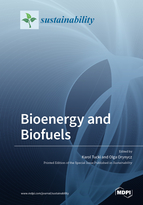Bioenergy and Biofuels
A special issue of Sustainability (ISSN 2071-1050). This special issue belongs to the section "Energy Sustainability".
Deadline for manuscript submissions: closed (1 December 2020) | Viewed by 19286
Special Issue Editors
Interests: biofuels; engines; turbines; energy engineering; environment; sustainability
Special Issues, Collections and Topics in MDPI journals
Interests: energy technologies; energy modeling; technology management; sustainable development; manufacturing engineering; emission
Special Issues, Collections and Topics in MDPI journals
Special Issue Information
Dear Colleagues,
The condition of the fuel and energy sector reflects the state of the economy around the world. New technologies in the energy sector and management of its development together with a dynamically changing environment, as well as care for sustainable development and energy security, make the energy and automotive industry the most important sectors of the economy, whose dynamic development has been observed for many years. It should be emphasized that an important factor mobilizing the search for modern technologies, especially in energy and transport, is progressive climate change closely related to greenhouse gas emissions.
This Special Issue of Sustainability aims to provide a forum for the exchange of the latest technical and technological information, dissemination of high-quality research results, and presentation of the latest achievements in the field of bioenergy and biofuels, which can contribute to improving the wellbeing of society in the context of sustainable development.
This Special Edition deals with issues related to the reduction of CO2 emissions in the context of the use of biofuels and advanced energy systems based on renewable energy sources, as well as issues related to clean energy in the context of storage techniques and technologies. The contribution should reflect the latest research developments that are in line with the strategic development of global energy policy.
Dr. Karol Tucki
Dr. Olga Orynycz
Guest Editors
Manuscript Submission Information
Manuscripts should be submitted online at www.mdpi.com by registering and logging in to this website. Once you are registered, click here to go to the submission form. Manuscripts can be submitted until the deadline. All submissions that pass pre-check are peer-reviewed. Accepted papers will be published continuously in the journal (as soon as accepted) and will be listed together on the special issue website. Research articles, review articles as well as short communications are invited. For planned papers, a title and short abstract (about 100 words) can be sent to the Editorial Office for announcement on this website.
Submitted manuscripts should not have been published previously, nor be under consideration for publication elsewhere (except conference proceedings papers). All manuscripts are thoroughly refereed through a single-blind peer-review process. A guide for authors and other relevant information for submission of manuscripts is available on the Instructions for Authors page. Sustainability is an international peer-reviewed open access semimonthly journal published by MDPI.
Please visit the Instructions for Authors page before submitting a manuscript. The Article Processing Charge (APC) for publication in this open access journal is 2400 CHF (Swiss Francs). Submitted papers should be well formatted and use good English. Authors may use MDPI's English editing service prior to publication or during author revisions.
Keywords
- Energy sector
- Alternative fuels
- Clean energy
- Renewable energy sources







